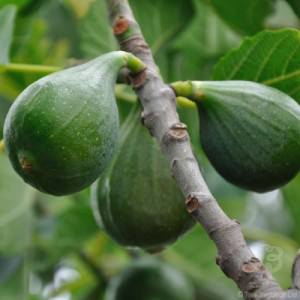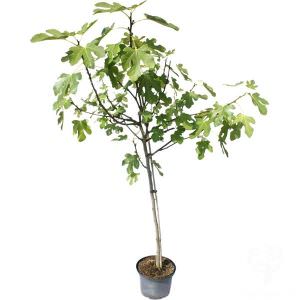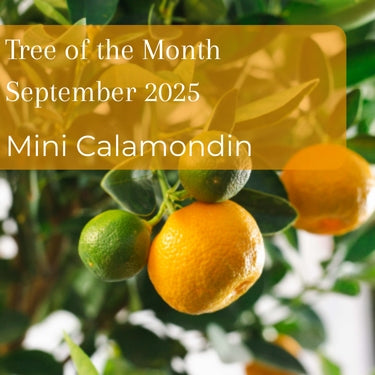How to Care for Fig Trees
Quick Facts:
- Latin name: Ficus carica
- Hardiness: Hardy down to -10°C. Suitable for growing across the UK and Ireland.
- Pollination: Variable. Dependant on variety.
- Height and spread: Variable. Dependant on rootstock.
- Flowering: Spring
- Harvesting: Autumn
- Difficulty: Easy
Far from being the delicate and temperamental plant you might imagine, with the right cultivar and care, growing figs in the UK is simple. In fact, fig trees are more adaptable than you might imagine, and can grow brilliantly in pots as well as in the ground.
The brown turkey variety that we stock in two sizes is the classic choice for British gardeners as it grows brilliantly in our cool climate . Don't fix it if it ain't broken!
Planting
 On receiving your fig tree, it's important that you remove it from the outer packaging immediately and store it in a suitable place until you're ready to plant - in winter, this may be a shed or garage to prevent frost damage. We advise that you plant your tree in September/October or late February/March when the tree is dormant and the roots are not growing.
On receiving your fig tree, it's important that you remove it from the outer packaging immediately and store it in a suitable place until you're ready to plant - in winter, this may be a shed or garage to prevent frost damage. We advise that you plant your tree in September/October or late February/March when the tree is dormant and the roots are not growing.
Try and choose somewhere that gets plenty of sunshine but is sheltered from strong wind and frost; all fruit trees need sunshine to ripen their fruit. Your tree will do best if planted into deep, well draining, loamy soil.
An hour before planting your tree, water the pot thoroughly. Remove the tree from its container and gently tease out the roots. Prune any that are damaged or broken. Dig a hole roughly three times the width of the trees roots, but no deeper, then plant the tree with the bud union at ground level. Back fill any gaps with the soil mix you removed earlier but don't pack the soil too tightly around the tree.
Repotting
If you're planning to grow your tree in a pot, it will require repotting into a larger container in the first 12 months, then every 2 - 3 years until it reaches its full height. Look out for the following signs that your apple tree is ready for a new home:
- Does your tree look less healthy than it used to?
- Does it seem to dry out quicker?
- Are there roots growing out of the holes in the bottom of the pots?
- Has the tree been in the same pot for 3 years or more?
Remember to always choose deep pots with drainage holes! Try to repot in the winter months to minimise the risk of damaging the roots.
Some tips for repotting:
- The soil in the tree pot should be slightly moist; water thoroughly an hour before repotting to achieve this
- Loosen the soil around the edge of the pot and pull the tree out by the base of the main stem
- If you are moving your tree to a bigger pot, add some extra soil into the bottom of the pot before you insert the plant
- Fill in with a mix of soil and compost.
- Water the plant thoroughly, and keep it well watered for several weeks
Once the tree is fully grown, it will be too big for repotting, but you will still need to replace 30-50% of the compost every other year, so the tree does not exhaust its supply of nutrients.
Feeding
Feeding your fig tree will help it to gain all the nutrients it needs to fruit. Late winter is an ideal time, and we would advise using a granular rose fertiliser according to packet instructions, as these are potassium-rich.
Mulching
Mulching is the term used for the layer of organic material that is placed on top of the soil around your plants every year. It has a whole host of benefits, including keeping the soil moist and nutrient-rich throughout summer and discouraging weeds. The best time to do this is in late spring (April-May) or autumn (October).
First, prepare the ground by removing debris and weeds and water the surface of the soil if it is dry. Apply a thin layer of well-rotted manure or good garden compost all around the tree - we suggest using John Innes No. 3.
Watering
We advise you to water your tree regularly until the plant is established. Once this point is passed, the plant will only require watering through spring and summer. The water around once a week, and more frequently in very hot weather. Make sure you always water the roots, and avoid getting water on the leaves of the plant, as this encourages disease and leaf scorch.
When fruit trees are grown in containers, they will have more restricted access to water than those growing in the garden. so will need watering with greater regularity. As a rule of thumb stick your finger into the first inch of topsoil and if it feels medium dry, water immediately.
Pruning
 Most fig trees grown in gardens are left to grow in quite a natural bush shape, and are very easy to train. The best time to prune your tree is in winter, when the tree is dormant.
Most fig trees grown in gardens are left to grow in quite a natural bush shape, and are very easy to train. The best time to prune your tree is in winter, when the tree is dormant.
First, remove any branches that are growing towards the centre of the tree instead of pointing outwards, as these will not get enough sunlight to produce fruit. Then remove any branches that are dead, diseased or dying.
Lastly, cut back all but the main branches and leave six or so buds on each stem. Once your tree has reached its full height, or a height you are happy with, you can also cut the main branches back by about a third, which will ensure your tree doesn't grow much taller.
Fruit and Flowers
Your tree should break out into beautiful blossom in spring, and after a couple of years, fruit should appear in summer. At this point, it might be an idea to invest in a fruit cage or fruit netting to deter birds. The fruit should be ripe by September/October and is ready for picking.
Winter Care
Your tree will go into dormancy over winter and lose all its leaves - this is normal! Move your tree into the greenhouse or conservatory (basically somewhere sheltered) when the temperatures begin to drop to protect it from extreme temperatures and frosts.
If your tree flowers before the last of the spring frosts, you may need to wrap it in horticultural fleece on frosty nights, to prevent the delicate flowers being damaged.
Did you know that these trees also make great gifts for loved ones? See our range of fig tree gifts.


